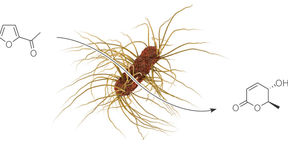Scientists found new ways to utilise biorefinery chemicals

Tailor-made designer bacteria as future tools in the valorisation of biorefinery furans. Image: Jan Deska
Researchers of the Synthetic Organic Chemistry group at Aalto University have established an innovative system using enzymes for the valorisation of biogenic furans, leading to organic structures that are found for example in fragrances, pharmaceuticals and complex bioactive natural products, such as vitamins.
Furfural is a common precursor to many furan-based chemicals. It is an important chemical platform derived from lignocellulosic biomass, from which multiple successful approaches towards furan-derived biofuels and green solvent solutions have arisen over the past years. However, when it comes to applications in fine chemical production, lack of complexity and the requirement for environmentally questionable and costly heavy metal catalysts poses severe challenges en route to high-value added chemical products.
Relying fully on Nature's catalysts – the enzymes – the technology now established provides highest biocompatibility and a much greener footprint compared to traditional approaches.
By trying to imitate classical chemistry that is not originally found in Nature, aim is to extent the biocatalytic toolbox and use enzymes in a more versatile manner.
“In this particular enzymatic reaction, we were not only able to substitute the commonly used iridium, that is one of the rarest elements in Earth's crust and thus prohibitively expensive, with a simple protein catalyst. Utilizing enzymes in this transformation, we can now for the first time conduct the reaction in a more stereoselective fashion and hence obtain the valorised lactone products with higher purity", says postdoctoral researcher Yu-Chang Liu.
New opportunities to merge traditional chemistry with modern biotechnology
The researchers were further able to bring the newly discovered enzymatic function back in a natural environment by inserting the genetic code of the required protein into a bacterial host. Thus, one of the key transformations can be performed within a particularly designed microorganism leading to the prospect of using cells to produce high-value chemicals from furans.
“With the introduction of truly non-natural functions into living organisms, we will be capable to significantly expand biological production scenarios in the future. The ability to convince microorganisms to also engage in transformations that are not naturally encoded in any biosynthetic pathway opens up opportunities to merge traditional chemistry strategies with the powerful new world of modern biotechnology”, explains research leader Professor Jan Deska.
The study "Enantioconvergent Biocatalytic Redoxisomerization" was recently published in Angewandte Chemie International Edition 2018, 57, https://onlinelibrary.wiley.com/doi/abs/10.1002/anie.201804911, thereby supplementing an initial preliminary publication by the group from 2014 (Nature Communications, 2014, 5, 5278).
The work was funded by the Academy of Finland, the Novo Nordisk Foundation and the German Research Foundation.
More information:
Professor Jan Deska
[email protected]
Aalto University, Department of Chemistry and Materials Science
- Published:
- Updated:
Read more news

DeployAI Partners Gather for Heart Beat Meeting in Helsinki
The European DeployAI project's partners gathered for the Heart Beat meeting hosted by Aalto University Executive Education in Helsinki.
Get to know us: Associate Professor Maria Sammalkorpi
Sammalkorpi received her doctorate from Helsinki University of Technology 2004. After her defence, she has worked as a researcher at the Universities of Princeton, Yale and Aalto.
Aalto computer scientists in ICML 2024
Computer scientists in ICML 2024